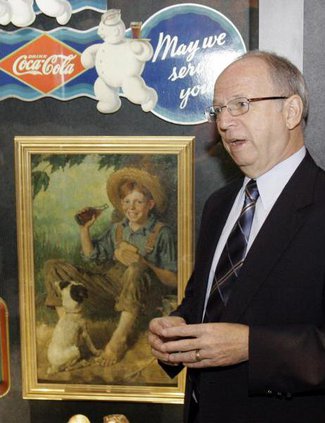The beverage company is searching for missing one-of-a-kind oil paintings that it commissioned from the Americana master more than 74 years ago. Each could be worth more than $500,000 if sold at auction.
The paintings were among six works depicting children that Rockwell did for Coca-Cola’s advertising campaigns of the late 1920s and early 1930s. The company has the other three paintings — including two on display at the new World of Coca-Cola museum in downtown Atlanta and another that hangs in the executive offices of its world headquarters nearby.
The paintings, described by Coca-Cola’s archivist as ‘‘seminal pieces’’ of the company’s history, were likely lost over time because they were used to create magazine and poster advertisements in an age when Coke employees wouldn’t have thought to hold onto them once the ads ran.
‘‘If anybody knows where these missing children are, we’d like to know about it,’’ says archivist Phil Mooney.
For years, Coca-Cola has tried to solve the mystery of what happened to the missing Rockwells. Coke has an undisclosed budget to purchase the paintings, if need be, but it won’t say how much it’s willing to spend for them.
‘‘If anybody finds (a painting), I’d like to think they would give it to us but that’s unlikely as there’s a market for these things,’’ Mooney said.
The three missing works are:
—‘‘The Old Oaken Bucket,’’ 1932, which depicts a boy sitting on a well with a small wooden barrel of Coke bottles in his lap.
—‘‘Wholesome Refreshment,’’ 1928, a sepia tone magazine ad made for The Saturday Evening Post that depicts a smiling young man lounging with a Coke while well-dressed adults, circa 1920, are playing with children. At the bottom is a legend that says ‘‘8 million a day.’’
—‘‘Office Boy — 4 p.m. — The Pause That Refreshes,’’ 1930, depicting a smiling boy in a suit and tie carrying a tray of two bottles of Coke and two glasses and opening a door marked ‘‘Vice President.’’
In the era when a bottle of Coca-Cola only cost a nickel, Rockwell likely was paid at least $2,000 a painting, Mooney said.
The company discusses the missing paintings on its Web site. Tour guides at Coke’s museum tell visitors about the Rockwells. The company regularly gets letters and phone calls from collectors about rare Coke memorabilia.
But there have been few leads over the years regarding the paintings, prompting Mooney to speculate that they may not have survived the demands of time — either discarded as unwanted advertising fodder or painted over into other works by the popular artist.
Fortune guided Coke to recover two of the Rockwells (the company has always had the 1935 painting ‘‘Out Fishin’’’ at Coke headquarters). A former employee returned the 1934 painting ‘‘Carry Me Back to Old Virginny’’ in the late 1990s.
In 2001, a retired executive from the Kentucky company that printed a Coke calendar in 1930s that featured the paintings contacted Mooney and sold the 1931 painting ‘‘Barefoot Boy’’ back to the company for an undisclosed sum, although Mooney said the price paid was ‘‘under market value.’’
Today, ‘‘Barefoot Boy’’ can be seen in the lobby of the new Coke museum and ‘‘Carry Me Back to Old Virginny’’ is in a gallery elsewhere in the building.
Such paintings were important in the pre-television era because entertainment came from reading stories and magazines, said Linda Pero, curator of the Norman Rockwell museum in Stockbridge, Mass.
‘‘The illustrations that went with it was a very big part of the culture,’’ Pero said. ‘‘So in that sense, to the collectibles market, these are really important images.’’
Pero said Rockwell paintings commissioned by the soft drink company, but ultimately not used, have been auctioned for nearly $300,000 each as recently as 2003. Mooney and Rockwell expert Donald Stoltz said the missing paintings easily could fetch at least $500,000 at auction because they were used in official Coke ads.
That’s partly because when Coke hired Rockwell to create their ads, the painter was already ‘‘fairly famous,’’ said Stoltz, co-author with his brother, Marshall, of the 1985 book ‘‘The Advertising World of Norman Rockwell.’’
‘‘They picked him not because of his fame, but because he did have that mass appeal. ... That’s why those ads became so sought after,’’ Stoltz said. ‘‘To try to track these down is very difficult. It’s tough tracking down the reprint.’’
————
On the Net:
Missing Rockwell paintings: http://www.thecoca-colacompany.com
Norman Rockwell Museum: http://www.nrm.org/




